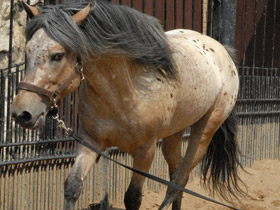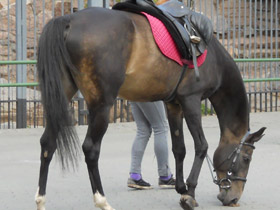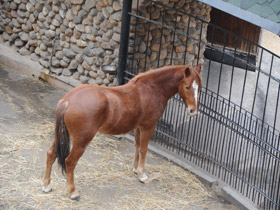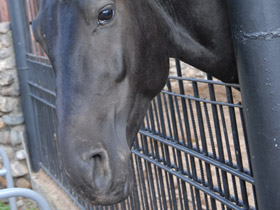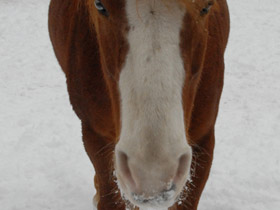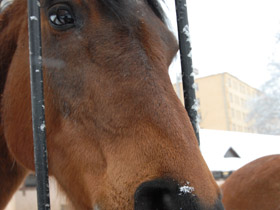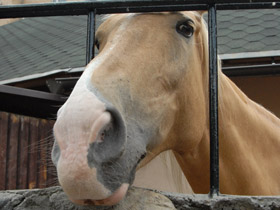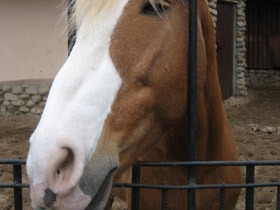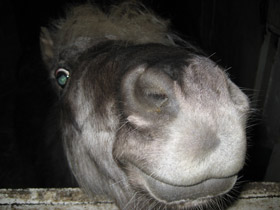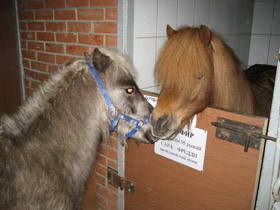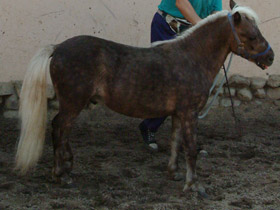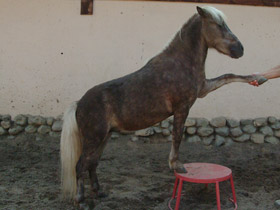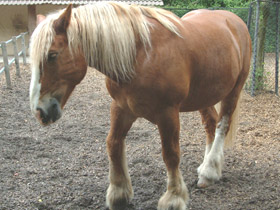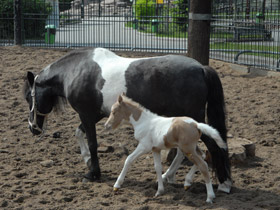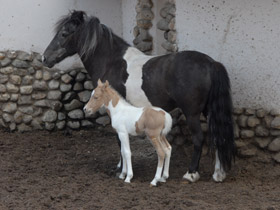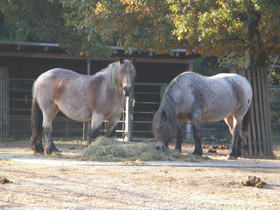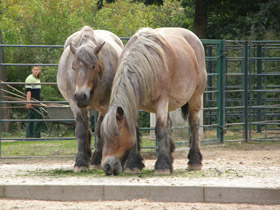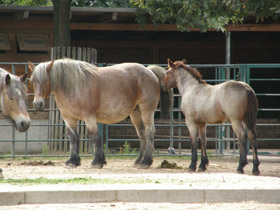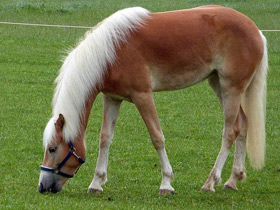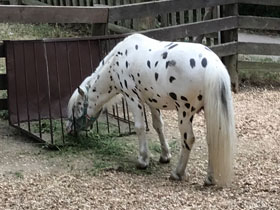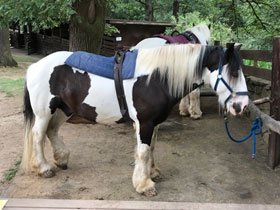The horse (Equus ferus caballus)
The horse (Equus ferus caballus) is a domesticated, one-toed, hoofed mammal. It belongs to the taxonomic family Equidae and is one of two extant subspecies of Equus ferus. The horse has evolved over the past 45 to 55 million years from a small multi-toed creature, close to Eohippus, into the large, single-toed animal of today. Humans began domesticating horses around 4000 BCE, and their domestication is believed to have been widespread by 3000 BCE. Horses in the subspecies caballus are domesticated, although some domesticated populations live in the wild as feral horses. These feral populations are not true wild horses, which are horses that never have been domesticated. There is an extensive, specialized vocabulary used to describe equine-related concepts, covering everything from anatomy to life stages, size, colors, markings, breeds, locomotion, and behavior.
Horses are adapted to run, allowing them to quickly escape predators, and possess an excellent sense of balance and a strong fight-or-flight response. Related to this need to flee from predators in the wild is an unusual trait: horses are able to sleep both standing up and lying down, with younger horses tending to sleep significantly more than adults. Female horses, called mares, carry their young for approximately 11 months and a young horse, called a foal, can stand and run shortly following birth. Most domesticated horses begin training under a saddle or in a harness between the ages of two and four. They reach full adult development by age five, and have an average lifespan of between 25 and 30 years.
Horse breeds are loosely divided into three categories based on general temperament: spirited "hot bloods" with speed and endurance; "cold bloods", such as draft horses and some ponies, suitable for slow, heavy work; and "warmbloods", developed from crosses between hot bloods and cold bloods, often focusing on creating breeds for specific riding purposes, particularly in Europe. There are more than 300 breeds of horse in the world today, developed for many different uses.
Horses and humans interact in a wide variety of sport competitions and non-competitive recreational pursuits as well as in working activities such as police work, agriculture, entertainment, and therapy. Horses were historically used in warfare, from which a wide variety of riding and driving techniques developed, using many different styles of equipment and methods of control. Many products are derived from horses, including meat, milk, hide, hair, bone, and pharmaceuticals extracted from the urine of pregnant mares. Humans provide domesticated horses with food, water, and shelter, as well as attention from specialists such as veterinarians and farriers.
Origin and diversity of breeds
Equus ferus caballus is a domesticated perissodactyl mammal of the Equidae family. It is a large, herbivorous perissodactyl with a long, arched neck and a long mane.
The Equus Ferus Caballus is believed to have been first domesticated by ancient humans about 9,000 years ago. Since then, more than 400 breeds have been bred, varying greatly in size, build, head shape, colour, etc. The smallest horses are the Argentine Falabella breed, 70-76 cm in height, the average weight of a pony is 100-200 kg, large riding horses weigh 400-600 kg and the heaviest breeds weigh 700-900 kg; the heaviest - the English heavy horses (Shires) - can weigh over 1400 kg.
Biology
Specific terms and specialized language are used to describe equine anatomy, different life stages, colors, and breeds.
Lifespan and life stages
Depending on breed, management and environment, the modern domestic horse has a life expectancy of 25 to 30 years. Uncommonly, a few animals live into their 40s and, occasionally, beyond.The oldest verifiable record was "Old Billy", a 19th-century horse that lived to the age of 62. In modern times, Sugar Puff, who had been listed in Guinness World Records as the world's oldest living pony, died in 2007 at age 56.
Regardless of a horse or pony's actual birth date, for most competition purposes a year is added to its age each January 1 of each year in the Northern Hemisphere and each August 1 in the Southern Hemisphere. The exception is in endurance riding, where the minimum age to compete is based on the animal's actual calendar age.
The following terminology is used to describe horses of various ages:
Foal
A horse of either sex less than one year old. A nursing foal is sometimes called a suckling, and a foal that has been weaned is called a weanling. Most domesticated foals are weaned at five to seven months of age, although foals can be weaned at four months with no adverse physical effects.
Yearling
A horse of either sex that is between one and two years old.
Colt
A male horse under the age of four. A common terminology error is to call any young horse a "colt", when the term actually only refers to young male horses.
Filly
A female horse under the age of four.
Mare
A female horse four years old and older.
Stallion
A non-castrated male horse four years old and older. The term "horse" is sometimes used colloquially to refer specifically to a stallion.
Gelding
A castrated male horse of any age.
In horse racing, these definitions may differ: For example, in the British Isles, Thoroughbred horse racing defines colts and fillies as less than five years old. However, Australian Thoroughbred racing defines colts and fillies as less than four years old.
Movement
All horses move naturally with four basic gaits:
- the four-beat walk, which averages 6.4 kilometres per hour (4.0 mph);
- the two-beat trot or jog at 13 to 19 kilometres per hour (8.1 to 11.8 mph) (faster for harness racing horses);
- the canter or lope, a three-beat gait that is 19 to 24 kilometres per hour (12 to 15 mph);
- the gallop, which averages 40 to 48 kilometres per hour (25 to 30 mph), but the world record for a horse galloping over a short, sprint distance is 70.76 kilometres per hour (43.97 mph).
Besides these basic gaits, some horses perform a two-beat pace, instead of the trot. There also are several four-beat 'ambling' gaits that are approximately the speed of a trot or pace, though smoother to ride. These include the lateral rack, running walk, and tölt as well as the diagonal fox trot. Ambling gaits are often genetic in some breeds, known collectively as gaited horses. These horses replace the trot with one of the ambling gaits.
Behavior
Horses are prey animals with a strong fight-or-flight response. Their first reaction to a threat is to startle and usually flee, although they will stand their ground and defend themselves when flight is impossible or if their young are threatened. They also tend to be curious; when startled, they will often hesitate an instant to ascertain the cause of their fright, and may not always flee from something that they perceive as non-threatening. Most light horse riding breeds were developed for speed, agility, alertness and endurance; natural qualities that extend from their wild ancestors. However, through selective breeding, some breeds of horses are quite docile, particularly certain draft horses.
Horses are herd animals, with a clear hierarchy of rank, led by a dominant individual, usually a mare. They are also social creatures that are able to form companionship attachments to their own species and to other animals, including humans. They communicate in various ways, including vocalizations such as nickering or whinnying, mutual grooming, and body language. Many horses will become difficult to manage if they are isolated, but with training, horses can learn to accept a human as a companion, and thus be comfortable away from other horses. However, when confined with insufficient companionship, exercise, or stimulation, individuals may develop stable vices, an assortment of bad habits, mostly stereotypies of psychological origin, that include wood chewing, wall kicking, "weaving" (rocking back and forth), and other problems.
Sleep patterns
Horses are able to sleep both standing up and lying down. In an adaptation from life in the wild, horses are able to enter light sleep by using a "stay apparatus" in their legs, allowing them to doze without collapsing. Horses sleep better when in groups because some animals will sleep while others stand guard to watch for predators. A horse kept alone will not sleep well because its instincts are to keep a constant eye out for danger.
Unlike humans, horses do not sleep in a solid, unbroken period of time, but take many short periods of rest. Horses spend four to fifteen hours a day in standing rest, and from a few minutes to several hours lying down. Total sleep time in a 24-hour period may range from several minutes to a couple of hours, mostly in short intervals of about 15 minutes each. The average sleep time of a domestic horse is said to be 2.9 hours per day.
Horses must lie down to reach REM sleep. They only have to lie down for an hour or two every few days to meet their minimum REM sleep requirements. However, if a horse is never allowed to lie down, after several days it will become sleep-deprived, and in rare cases may suddenly collapse as it involuntarily slips into REM sleep while still standing. This condition differs from narcolepsy, although horses may also suffer from that disorder.
Wild species surviving into modern times
A truly wild horse is a species or subspecies with no ancestors that were ever successfully domesticated. Therefore, most "wild" horses today are actually feral horses, animals that escaped or were turned loose from domestic herds and the descendants of those animals. Only two wild subspecies, the tarpan and the Przewalski's horse, survived into recorded history and only the latter survives today.
The Przewalski's horse (Equus ferus przewalskii), named after the Russian explorer Nikolai Przhevalsky, is a rare Asian animal. It is also known as the Mongolian wild horse; Mongolian people know it as the taki, and the Kyrgyz people call it a kirtag. The subspecies was presumed extinct in the wild between 1969 and 1992, while a small breeding population survived in zoos around the world. In 1992, it was reestablished in the wild by the conservation efforts of numerous zoos. Today, a small wild breeding population exists in Mongolia. There are additional animals still maintained at zoos throughout the world.
Haflinger
The Haflinger horse was bred in Austria, near the Tyrol. They are very suitable for working in the field and on the farm. The stallion was first registered with the Society of Horse Enthusiasts and Professional Breeders as early as 1874, but some reports suggest that the Haflinger had been bred from a cross between the semi-Arabian Bedawi and a purebred Tyrolean mare. Official recognition of the breed did not take place until 1898.
Haflingers are easily recognisable by their beautiful golden colour, which together with their magnificent white mane and equally beautiful tail, look quite impressive in the sun.
The Haflinger is considered very unpretentious and is mostly used by sportsmen and farmers, but is also common in the Austrian equestrian police and the Austrian army. The Haflinger is often used for cleaning wood and other heavy work, where its great strength is irreplaceable. As they have been bred for mountain conditions, they are usually unpretentious when it comes to the roughness of the roads.
The Haflinger is intelligent enough to be easy to train. The horse's calm demeanour allows it to be ridden by small children without fear, and it can also be ridden by those who are ill-equipped and afraid of horses.

















